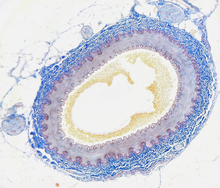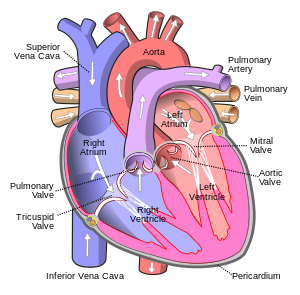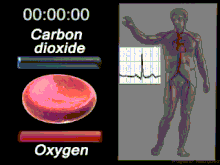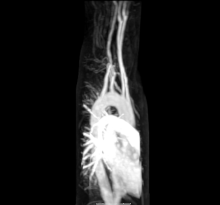Human cardiovascular system
The main components of the human cardiovascular system are the heart, blood, and blood vessels.[3] It includes: the pulmonary circulation, a "loop" through the lungs where blood is oxygenated; and the systemic circulation, a "loop" through the rest of the body to provide oxygenated blood. An average adult contains five to six quarts (roughly 4.7 to 5.7 liters) of blood, which consists of plasma, red blood cells, white blood cells, and platelets. Also, the digestive system works with the circulatory system to provide the nutrients the system needs to keep the heart pumping.
Pulmonary circulation
Main article: Pulmonary circulation
The pulmonary circulatory system is the portion of the cardiovascular system in which oxygen-depleted blood is pumped away from the heart, via thepulmonary artery, to the lungs and returned, oxygenated, to the heart via the pulmonary vein.
Oxygen deprived blood from the vena cava, enters the right atrium of the heart and flows through the tricuspid valve (right atrioventricular valve) into the right ventricle, from which it is then pumped through the pulmonary semilunar valve into the pulmonary artery to the lungs. Gas exchange occurs in the lungs, whereby CO2 is released from the blood, and oxygen is absorbed. The pulmonary vein returns the now oxygen-rich blood to the heart.
Systemic circulation
Main article: Systemic circulation
Systemic circulation is the portion of the cardiovascular system which transports oxygenated blood away from the heart, to the rest of the body, and returns oxygen-depleted blood back to the heart. Systemic circulation is, distance-wise, much longer than pulmonary circulation, transporting blood to every part of the body.
Coronary circulation
Main article: Coronary circulation
The coronary circulatory system provides a blood supply to the heart. As it provides oxygenated blood to the heart, it is by definition a part of the systemic circulatory system.
Heart
Main article: Human heart
The heart pumps oxygenated blood to the body and deoxygenated blood to the lungs. In the human heart there is one atrium and one ventricle for each circulation, and with both a systemic and a pulmonary circulation there are four chambers in total: left atrium, left ventricle, right atrium and right ventricle. The right atrium is the upper chamber of the right side of the heart. The blood that is returned to the right atrium is deoxygenated (poor in oxygen) and passed into the right ventricle to be pumped through the pulmonary artery to the lungs for re-oxygenation and removal of carbon dioxide. The left atrium receives newly oxygenated blood from the lungs as well as the pulmonary vein which is passed into the strong left ventricle to be pumped through the aorta to the different organs of the body.
Closed cardiovascular system
The cardiovascular systems of humans are closed, meaning that the blood never leaves the network of blood vessels. In contrast, oxygen and nutrients diffuse across the blood vessel layers and enters interstitial fluid, which carries oxygen and nutrients to the target cells, and carbon dioxide and wastes in the opposite direction. The other component of the circulatory system, the lymphatic system, is not closed.
Oxygen transportation
Main article: Blood#Oxygen transport
About 98.5% of the oxygen in a sample of arterial blood in a healthy human breathing air at sea-level pressure is chemically combined with haemoglobin molecules. About 1.5% is physically dissolved in the other blood liquids and not connected to haemoglobin. The haemoglobin molecule is the primary transporter of oxygen in mammals and many other species.
Development
The development of the circulatory system initially occurs by the process of vasculogenesis. The human arterial and venous systems develop from different embryonic areas. While the arterial system develops mainly from the aortic arches, the venous system arises from three bilateral veins during weeks 4 - 8 of human development.
Arterial development
Main article: Aortic arches
The human arterial system originate from the aortic arches and from the dorsal aortae starting from week 4 of human development. Aortic arch 1 almost completely regresses except to form the maxillary arteries. Aortic arch 2 also completely regresses except to form the stapedial arteries. The definitive formation of the arterial system arise from aortic arches 3, 4 and 6. While aortic arch 5 completely regreses.
The dorsal aortae are initially bilateral and then fuse to form the definitive dorsal aorta. Approximately 30 posterolateral branches arise off the aorta and will form the intercostal arteries, upper and lower extremity arteries, lumbar arteries and the lateral sacral arteries. The lateral branches of the aorta form the definitive renal, suprarrenal and gonadal arteries. Finally, the ventral branches of the aorta consist of the vitelline arteries and umbilical arteries. The vitelline arteries form the celiac, superior and inferior mesenteric arteries of the gastrointestinal tract. After birth, the umbilical arteries will form the internal iliac arteries.
Venous development
The human venous system develops mainly from the vitelline veins, the umbilical veins and the cardinal veins, all of which empty into the sinus venosus.
Measurement techniques
- Electrocardiogram—for cardiac electrophysiology
- Sphygmomanometer and stethoscope—for blood pressure
- Pulse meter—for cardiac function (heart rate, rhythm, dropped beats)
- Pulse—commonly used to determine the heart rate in absence of certain cardiac pathologies
- Heart rate variability -- used to measure variations of time intervals between heart beats
- Nail bed blanching test—test for perfusion
- Vessel cannula or catheter pressure measurement—pulmonary wedge pressure or in older animal experiments.





No comments:
Post a Comment